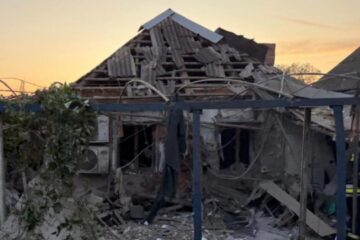International and Ukrainian analysts are deliberating on how Ukrainian military know-how changes the course of the war
The Russian occupying army does not stop terrorizing peaceful Ukrainian cities, but instead is increasingly ramping up the intensity of such attacks. According to the General Staff, Russia launched almost four thousand Shahed strike drones and about 260 missiles of various types into Ukraine in July alone. With such tactics, the Russian Federation aims to weaken the Ukrainian population morally and physically, exhaust the Air Defense Forces and damage the infrastructure in rear-area cities. Here, international and Ukrainian defense analysts are deliberating on how Ukraine can respond to Russian terror, where prospects lie for Ukrainian innovative technologies to facilitate the production and use of drones, and where the Western partners’ strategic interest in cooperating with Ukraine lies.
фото
DRONES IN AN ASYMMETRIC WAR
Russia’s full-scale war against Ukraine represents a clash between two fundamentally different military approaches, where a numerically superior aggressor is facing an adversary that has to rely on tactics and innovation, and rapid adaptation to new challenges to overcome the advantage of the numerically superior force.
According to Colonel Markus Reisner, a military analyst at the Ministry of Defense in Vienna and head of the Officer Training Institute at the Theresian Military Academy, Russia’s war against Ukraine is “a classic example of an asymmetric war, in which one side with significantly greater military power fights against a smaller, more flexible and technologically innovative force.”
“Ukraine has achieved impressive results in this domain and continues to make further progress, thanks to its ability to absorb Western technologies and respond in a flexible manner to the ever-changing dynamics of war. This was manifested, in particular, in the successful fight against Russian maneuver force grouping and the use of drones,” Colonel Markus Reisner, head of the Theresian Military Academy Officer Training Institute, said in an exclusive comment to an Ukrinform correspondent.
Фото Markus Reisner
That being said, drones account for 80 percent of successful hits on the battlefield, according to the General Staff of the Armed Forces of Ukraine.
On July 31, President Volodymyr Zelensky enacted a legislation to ensure sufficient and smooth funding from government for weapons procurements for the Defense Forces. The legislation includes a UAH 412.3 billion hike in defense spending, including UAH 216 billion that will go to production and procurement of weapons, military equipment and drones.
But the aggressor is not standing still. According to the Defense Intelligence Agency (HUR) within the Ministry of Defense, Russia is set to scale production of drones to reach the daily output of 500 drones.
According to Defense News, Russia has around 900 companies involved in the production of uncrewed aerial vehicles (UAVs), including those used in attacks like the Shahed drones. A large portion (70%) of these companies are classified as small and medium enterprises. These companies have received significant funding, with an estimated USD 3 billion allocated to UAV development between 2022 and 2025. The Russian Federation is about to invest an additional USD 1.38 billion in UAV production by 2027. One major hub is the Alabuga plant in currently Moscow-occupied Republic of Tatarstan, where tens of thousands of workers are involved in assembling Shahed-136 (Geran-2) kamikaze UAVs. The city of Yelabuga that hosts the almost same named plant lies almost 1,200 kilometers from the Ukrainian border.
Фото Suspilne Novyny/Oleksandr Mahula
STRATEGIC IMPLICATIONS OF STRIKES ON RUSSIA’S REAR REGIONS
This, however, has long ceased to be an obstacle. In April 2024, production lines for deadly Russian weapons sustained damage in several attacks with HUR drones, and, on May 26 and June 15, 2025, unknown UAVs attacked Yelabuga again. Given Russia’s stated intention to destroy Ukraine (and the refusal to sit down at the negotiating table for constructive discussions), there is no reason whatsoever to bring such attacks to a halt. On August 2, for example, Ukraine’s Security Service (SBU) struck a Russian air base storing Shahed drones in the Krasnodar Krai region located at 230 kilometers from the current front line.
Serhiy Kuzan, a defense analyst and head of the Ukrainian Center for Security and Cooperation expressed the conviction that attacks on the enemy’s rear regions with long-range drones will continue, because this is the main way how Ukraine can protect its civilian infrastructure. “The main countermeasure is precisely the destruction of production facilities on the territory of the Russian Federation, as well as the destruction of enemy’s drone storage sites… Early July saw a wave of drone strikes on factories in Russia involved in the manufacture of drone components. Such attacks have strategic implications, since not only do they destroy prepositioned drones at launch stations, but also immediately affect the adversary’s ability to produce them on a large scale,” Kuzan noted in a comment to Ukrinform.
Serhiy Kuzan emphasized that Ukraine has since the fall of 2024 been operating a program aimed to decentralize procurements of drones. This would allow combat commanders to promptly purchase the requisite equipment needed on the frontline. This measure has already helped increase the ratio of successful hits on enemy targets by 40%. One hundred percent of combat units of the Armed Forces of Ukraine have already become involved in this program, according to deputy head of the Presidential Office, Pavlo Palisa.
Austrian Army Colonel Markus Reisner, the head of the Officer Training Institute at the Theresian Military Academy, highlights the significant role drones are playing in modern warfare. “The key to Ukraine’s success has been its ‘army of drones.’ The Russian invaders are not directly confronted by tens of thousands of soldiers, but by hundreds of thousands of drones controlled by the military from a safe distance. FPV drones are used at the tactical level, medium-range drones at the operational level, and long-range strike drones at the strategic level. Thanks to the well-established and sustainable financing of decentralized production on a large scale, Ukrainian combat units are constantly receiving new drones,” Mr. Reisner argues.
According to the Austrian defense analyst, these capabilities enable Ukrainian forces to successfully confront Russian advancing formations and conduct new types of combat operations.
INTERNATIONAL PARTNERSHIP IN DRONE PRODUCTION
On top of that, Ukraine’s defense technological know-how creates new opportunities for investment. After Russia’s full-scale invasion of Ukraine, EU countries have revised not only their defense budgets, but also their respective defense strategies. In a comment to Ukrinform, military expert Serhiy Kuzan noted that additional assistance from international partners is vital for the further development and expansion of the Unmanned Systems Forces (world’s first unmanned systems forces ever). “This is not just about the weapons transfers, but about investments and procurements of modern and effective weapons directly from Ukrainian manufacturers. This contributes simultaneously to the development and growth of Ukraine’s defense-industrial complex, the inflow of investment into the economy, and the provision of the military with the necessary weapons – drones, missiles, artillery guns and shells, electronic warfare equipment, etc. This approach helps minimize the financial gap with Moscow,” Kuzan emphasized.
Domestic production covers approximately 50 percent of Ukraine’s military needs, according to Deputy Head of the Presidential Office Pavlo Palisa. In-country defense production is expected to reach around USD 15 billion in 2025, USD 5 billion up on the year before.
Фото Pavlo Palisa/Photo via Presidential Office
“The industry’s potential is estimated at USD 35 billion, the lack of funding being the main obstacle to this – and this could be an opportunity for Europe,” as noted by the Ukrainian Center for Security and Cooperation.
European countries should be interested in investing in drone production in Ukraine as ..none of the European countries has such technological development and know-how as the Ukrainians, Bundestag member, former Bundeswehr officer Roderich Kiesewetter told Ukrinform in a comment.
“Since none of the European countries has such technological development and know-how as the Ukrainians, it is in our best interest to support production and product development in Ukraine, so that later, if necessary, we can use Ukrainian know-how and production capacities,” the German politician noted.
Фото Rorerich Kiesewetter
Bundestag member Roderich Kiesewetter believes the prospects for cooperation with Ukraine in the field of drone production to be encouraging. At the same time, the “Danish model” announced in the summer of 2023 — a mechanism to provide direct support for Ukraine’s defense industry through partner countries directly financing the production of weapons or equipment for the Ukrainian Defense Forces — is, according to the expert, the most effective. “Unmanned systems are developing so rapidly that it is most advisable to integrate adaptations and knowledge immediately from the front line into development. Only Ukraine has such capabilities. Moreover, production in Ukraine is much cheaper and more efficient, while supporting the local economy,” Kiesewetter noted.
In addition to direct financing, European countries could also participate in production with their expertise and components, which allows diversifying sources of supply. This opinion was expressed in a comment to Ukrinform by Patrick Bolder, a strategic analyst and defense expert at the Hague Centre for Strategic Studies (HCSS) and former lieutenant colonel of the Royal Netherlands Air Force. “What contribution can we make to these efforts? First of all, finance manufacturers, help with knowledge, know-how, equipment, and components from which drones are made. The Netherlands has a pretty large production of microchips, and there is a considerable amount of knowledge in this domain. So I think that the Netherlands can help Ukraine with knowledge, financing and equipment – just like other countries can,” Mr. Bolder said.
Фото Patrick Bolder
Markus Reisner, Austrian Armed Forces Colonel, the head of the Officer Training Institute at the Theresian Military Academy, is confident that the extensive drone production system in Ukraine insures against Russian strikes, because a network of small-scale production is practically impossible to destroy. “Despite massive strikes on critical infrastructure and the defense-industrial complex in Ukraine, drone production is constantly growing in terms of both quality and quantity. This is a big problem, if not a nightmare, for the Russian invaders,” the Austrian defense expert argued.
That being said, there is strong export market potential for Ukrainian drones, Patrick Bolder told Ukrinform in a comment. “If you launch mass production of battlefield-tested drones – since they are manufactured in Ukraine and used in the war in Ukraine – then these drones with their sufficiently high productivity can be sold and generate revenue for the Ukrainian economy,” the Dutch expert noted.
Meanwhile, Russia is scaling up its armed forces. Commander-in-Chief of the Armed Forces of Ukraine, Oleksandr Syrsky, summing up the results achieved by the Armed Forces of Ukraine in July, reported on social media that the aggressor country is set to boost the strength of its occupying army, despite the fact that Russia had lost 33, 200 soldiers killed and wounded on Ukrainian battlefields over July alone (800 casualties more than in June).
“Despite this, the adversary is boosting its force grouping by adding nine thousand personnel every month. The Russian leadership aims to organize ten new divisions by the end of the year, two have already been formed,” Syrsky wrote. On a parallel track, the Russian Federation is doing everything it can to disrupt mobilization effort in Ukraine by staging psychological and information influence (PSYOP) operations targeting military enlistment authorities, and spreading lies about Ukraine’s alleged refusal to pay compensations for the bodies of the dead among other lies.
Фото
CLASSIC VICTORY FACTORS AND NEW WEAPONS SYSTEMS
Serhiy Kuzan, the head of the Ukrainian Center for Security and Cooperation, emphasizes that the Ukrainian government is looking for new military personnel, including through the 18-24 program, in order to boost its forces, particularly the unmanned systems forces. “The government has expanded the 18-24 program to include experts in unmanned technologies, including aerial vehicles and ground robotic platforms. Besides, the National Budget 2025 has been updated to absorb increased spending on the defense sector, in particular production and procurement of weapons, equipment and drones,” said Mr. Kuzan.
According to the head of the Officer Training Institute at the Theresian Military Academy, Austrian Armed Forces Colonel Markus Reisner, Ukraine’s defensive war should involve asymmetric operations and tactical flexibility, given the Russian Federation’s numerically more robust mobilization resource. An example is the successful use of naval drones against the Russian Black Sea Fleet. “In this war, as before, the classic factors like strength, space, time and information remain of relevance. The one who can use the latest weapons systems to turn these factors to their advantage will win. In this context, a positive example can be given for Ukraine: it has been able to dislodge the Russian Black Sea Fleet from the western part of the Black Sea (space) within a few months, using long-range, high-speed surface unmanned vehicles (strength), which operated “in real time”, guided by situational awareness provided by the West (information).
Patrick Bolder, a strategic analyst and defense expert at the Hague Centre for Strategic Studies (HCSS) and former lieutenant colonel of the Royal Netherlands Air Force, in his Ukrinform comment, emphasized that, over the three and a half years of the Russo-Ukrainian war, the role of drones on the battlefield has changed dramatically from reconnaissance/surveillance to offensive missions, indicating a profound transformation of how they are used. “Regarding the types of drones, the development and engineering of drones is currently underway, including unmanned ground vehicles or ground drones. I think there is still a lot to be achieved in this domain. I watched an interesting video about the development of Ukrainian drones named TERMIT. I think this can be an example of how the armed forces, the ground forces, can use drones. But there is also growth and development going on in the air segment – drones that deliver cargos, as well as ammunition, water, food… I believe this to be wholly new dimension of combat operations where victory is still achievable,” said Mr. Bolder.
Bundestag member Roderich Kiesewetter is of the opinion that the development of Ukrainian military know-how is of interest also in terms of further prospects for Ukraine’s potential NATO membership. “It would make sense for Ukraine to have ‘added value’ related to security. This is of importance for the EU and NATO member states, and, therefore, Ukraine’s integration into these two organizations will offer an additional advantage that could convince the states that have yet to decide on the issue of Ukraine’s membership in the Alliance,” said Mr. Kiesewetter.
Ukraine is confronting Russian threats by boosting up its potential for innovation and preparing a new edition of military doctrine, unique and cutting-edge. This experience is of value for Ukraine’s allies and could contribute the EU and NATO member countries in revising their respective military strategies and existing practical tactics.
Anna Kostyuchenko, Kyiv




